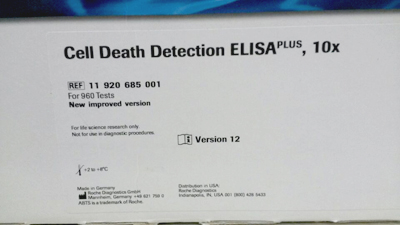|

Application
The Cell Death Detection ELISAPLUS, 10x photometric enzyme immunoassay is used for the quantitative in vitro determination of cytoplasmic histone-associated DNA fragments (mono- and oligonucleosomes) after induced cell death.
The kit contains a stop solution which allows users to terminate the substrate reaction and run the assay under defined conditions, making it suitable for use in high-throughput applications.
Product Description
Assay time:
3 - 4 hours
Negative control:
Depending on cell culture conditions, each exponentially growing permanent cell culture contains a certain amount of dead cells (typically approximately 3 - 8%). In the immunoassay, these inherent dead cells in the untreated sample (without a cell-death-inducing agent) will cause a certain absorbance value (negative control).
Positive control:
A DNA-histone complex serves as a positive control.
Sample material:
Cytoplasmic fractions (lysates) of cell lines, cells ex vivo, cell culture supernatants, and serum or plasma
Sensitivity:
The exact detection limit of dying/dead cells in a particular sample strongly depends on the kinetics of cell death, the cytotoxic agent used, and the amount of affected cells in the total cell population. Using U937/camptothecin (CAM) as a cellular model system for cell death, the immunoassay allows the specific detection of mono- and oligonucleosomes in the cytoplasmic fraction of 125 cell equivalents/well.
Specificity:
Anti-histone reacts with the histones H1, H2A, H2B, H3, and H4 of various species (e.g., human, mouse, rat, hamster, cow, opossum, Xenopus). Anti-DNA binds to single- and double-stranded DNA. Therefore, the ELISA allows the detection of mono- and oligonucleosomes from various species, and may be applied to measure apoptotic cell death in many different cell systems |